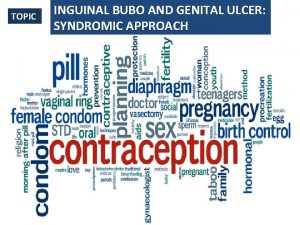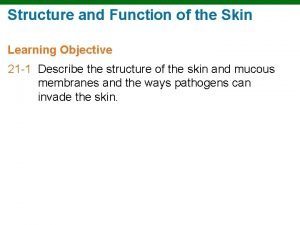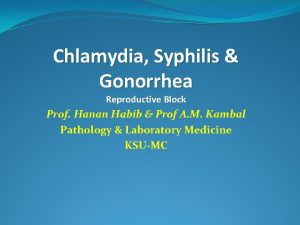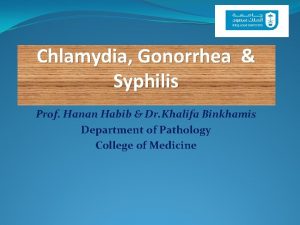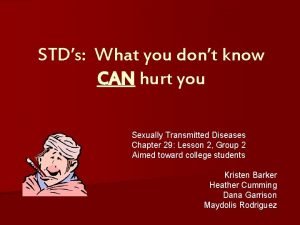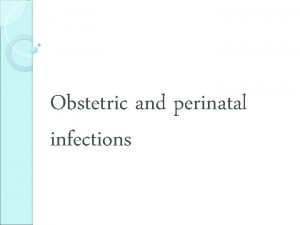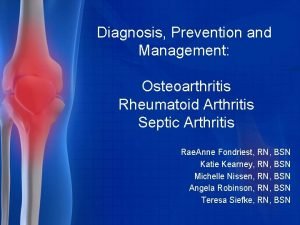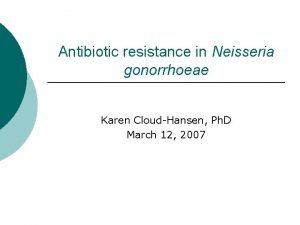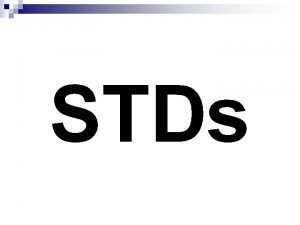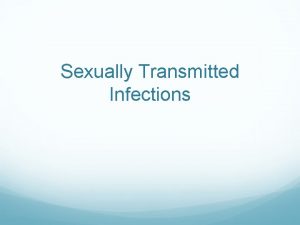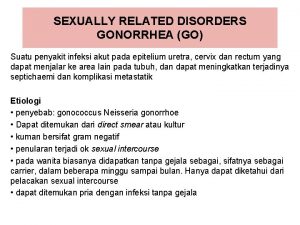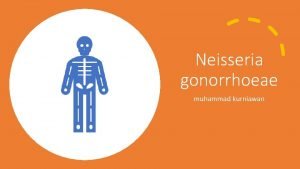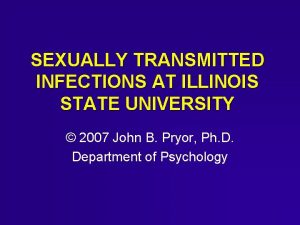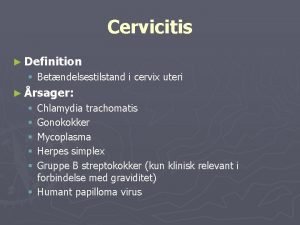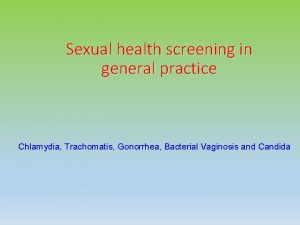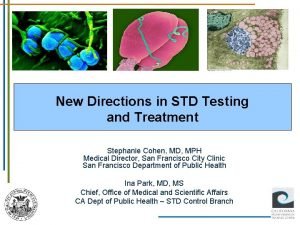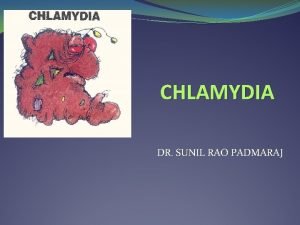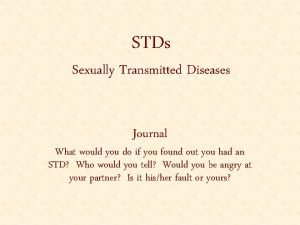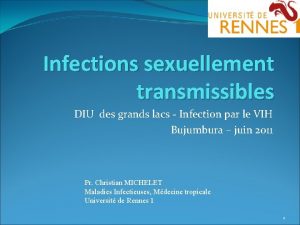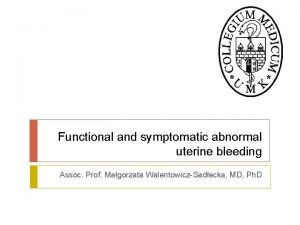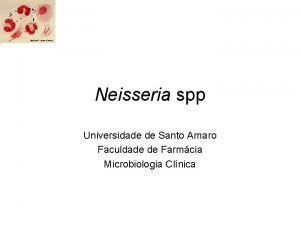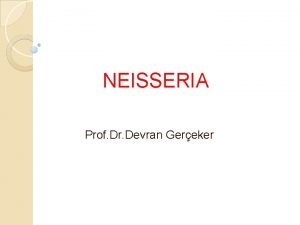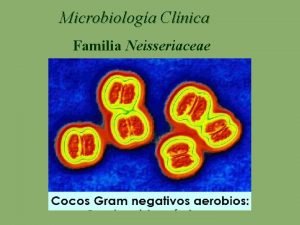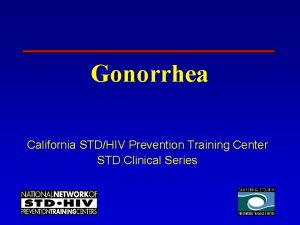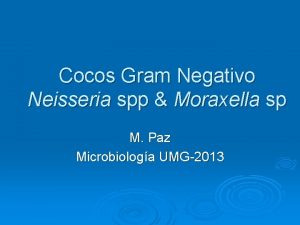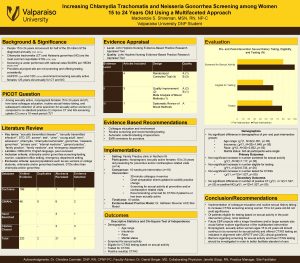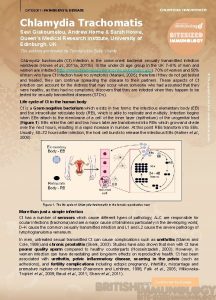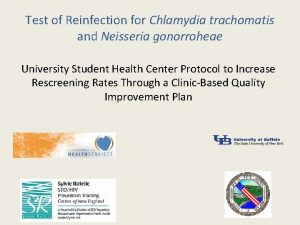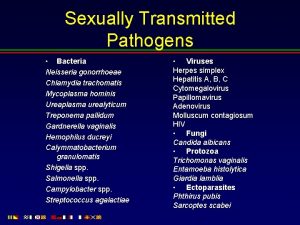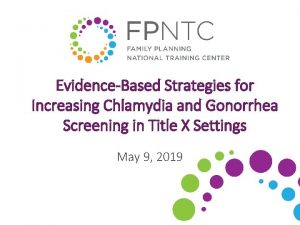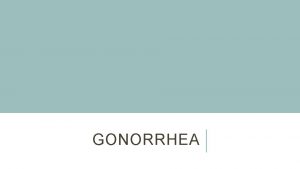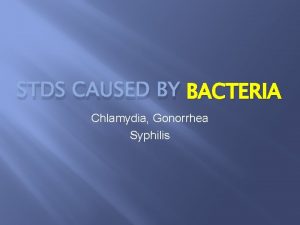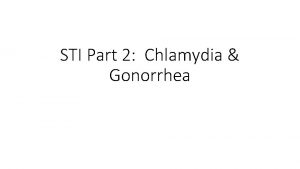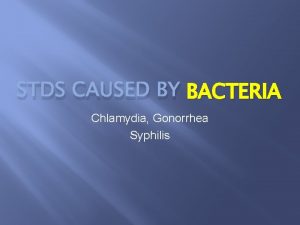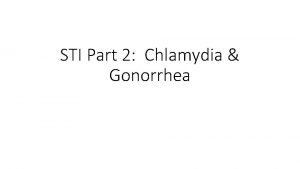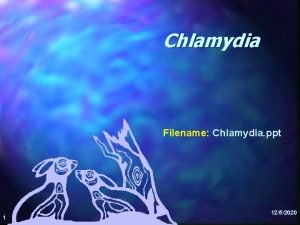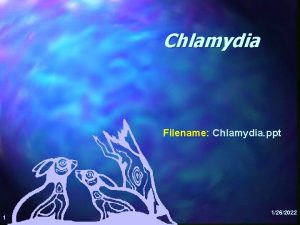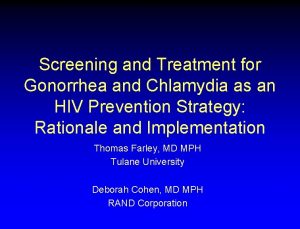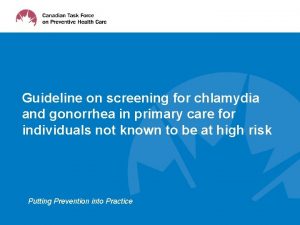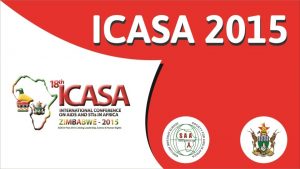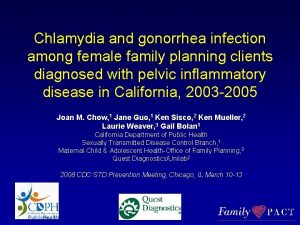Increasing Chlamydia Trachomatis and Neisseria Gonorrhea Screening among































- Slides: 31

Increasing Chlamydia Trachomatis and Neisseria Gonorrhea Screening among Women 15 -24 Years Old Using a Multifaceted Approach Mackenzie S. Shireman, MSN, RN, NP-C “I have neither given or received, nor tolerated others’ use of unauthorized aid”

Acknowledgments • Family and Friends • Dr. Christina Cavinder, DNP, RN, CPNP-PC, Advisor • Dr. Dan Berger MD, Collaborator and Mentor • Jenelle Sloop RN, Practice Manager • Ashley Jackson, CMA • Kayla Miller, EMR Specialist • Goshen Physician’s Bristol Family Medicine and Float Pool Colleagues

Background • People 15 to 24 years old account for half of the 20 million sexually transmitted diseases (STD) diagnosed annually (CDC, 2018) – Chlamydia trachomatis (CT) and Neisseria gonorrhea (NG) are most common (CDC, 2017 a) • Less than 12% of young adults and adolescents reported getting screened in the prior year (Cuffe et al. , 2016) • CT and NG infections are a source of significant public health concern • CT screening is currently performed about 50 -60% of the time nationally (NCQA, 2019) • Routine sexual history taking was not routinely being performed at project site resulting in missed opportunities (CDC, 2014 a; CDC, 2014 b; CDC, 2017 b; Ghanem & Tuddenham, 2018)

PICOT Question • Among sexually active, nonpregnant females 15 to 24 years old (P), how does colleague education, routine sexual history taking, and subsequent collection of urine specimen for sexually active women (I) compared to no standard practice (C) improve chlamydia and gonorrhea screening uptake (O) over a 10 -week period (T)?

Review of the Literature Keywords: “sexually transmitted disease*, ” “sexually transmitted infection*, ” STD, STI, screen*, test*, “urine, ” “young adult, ” teen*, adolescen*, chlamydia, “chlamydia trachomatis, ” gonorrhea, “neisseria gonorrhea, ” “primary care, ” “internal medicine, ” “general practice, ” “family medicine, ” “emergency department” • Literature search – Databases, handsearching, citation chasing • 8 articles selected • Appraisal – John Hopkins Nursing Evidence. Based Practice Research Appraisal Tool (Dang & Dearholt, 2017) Evidence Articles Level Included Design Quality I 4 Randomized Controlled Trial (4) A (1) B (3) II 3 Quality A (2) Improvement (2) B (1) Meta Analysis of Mixed Methods (1) III 1 Systematic A Review of Mixed Methods

Decision to Change Practice • National Clinical Guidelines – USPSTF (2014) and CDC (2014 c) recommend screening sexually active females <25 y/o annually for CT and NG – Healthy People 2020 initiative called for increasing proportion of sexually active females <24 years screened annually for chlamydia • Best practice interventions from literature – Staff education and involvement, routine screening and testing, automatic collection of specimens for testing, EMR reminders for providers • Best practice most appropriate for project – Staff education, routine screening, specimen collection if sexually active (Di. Vasta et al. , 2016; Goyal et al. , 2017; Guy et al. , 2011; HHS, Healthy People 2020, 2019; Kettinger, 2013; Lawton et al. , 2010; Mc. Nulty et al. , 2014; Taylor, Frasure. Williams, Burnett, & Park, 2016; Tebb, Wibbelsman, & Neuhas, 2009)

Implementation • EBP Model: ACE Star • Eligibility: – Females 15 -24 y/o – Not pregnant, mentally disabled, incarcerated – Without urogenital complaints • IRB exempt • Site: Two provider family medicine clinic • Timeframe: 10 -weeks • Two step implementation 1. 2. 30 -minute colleague in-service Screening eligible patients • Chart preparation documentation served as checklist

Implementation yes no no yes Figure 1. Yes means test. Retrieved from https: //yesmeanstest. org

Evaluation/Data Collection • Data Collection – 10 -weeks pre-intervention vs. 10 -weeks postintervention – Collected via retrospective EMR audit based on ICD/CPT codes • Report run by EMR specialist • Manually checked for patient eligibility

Evaluation/Data Analysis • Demographics – – Age range Insurance Race Marital status • Primary outcomes – Number screened for sexual activity – Number eligible for CT/NG – Number tested for CT/NG • Secondary outcomes – Number positive for CT – Number positive for NG

Evaluation/Data Analysis • Data analysis – Statistical analyses • Descriptive statistics – Calculated frequencies • Chi square analyses – Performed using the Statistical Package for Social Sciences (SPSS) Version 25

Evaluation/Demographics Demographic Age Range Pre-intervention Post-intervention 15 -17 y/o 11 (61%) 8 (57%) 18 -24 y/o 7 (39%) 6 (43%) 10 (56%) 11 (79%) Commercial 8 (44%) 3 (21%) Caucasian or White 11 (61%) 8 (57%) African American or Black 2 (11%) 1 (7%) Hispanic or Latino 5 (28%) 3 (21%) Declined or Other 0 (0%) 2 (14%) Single 18 (100%) 14 (100%) Married 0 (0%) Insurance Medicaid Race Marital Status Frequency (%)

Evaluation/Demographics • Age Range Pre-Intervention 39% Post-Intervention 43% 61% 57% 15 to 17 Years Old 18 to 24 Years Old

Evaluation/Demographics • Insurance Pre-Intervention Post-Intervention 21% 44% 56% 79% Medicaid Commerical Medicaid Commercial

Evaluation/Demographics • Race Pre-Intervention Post-Intervention 14% 28% 21% 11% 61% 58% 7% White or Caucasian Black or African American Hispanic or Latino Declined/Other

Evaluation/Demographics • Marital Status Pre-Intervention Post-Intervention 100% Single Married

Evaluation/Demographics • Age Range – No significant difference between pre-intervention and post -intervention groups • (�� 2(1, N=32)=. 051, p>. 05) • Insurance – No significant difference between pre-intervention and post -intervention groups • (�� 2(1, N=32)=1. 849, p>. 05) • Race – No significant difference between pre-intervention and post -intervention groups • (�� 2(3, N=32)=2. 852, p>. 05) • Marital Status – Not applicable due to all patients being single

Evaluation/Primary Outcomes Outcome Frequency (%) Pre-Intervention Post-Intervention Screened for Sexual Activity 11 (61%) 11 (79%) Eligible for CT/NG Testing 5 (45%) 7 (64%) Tested for CT/NG 4 (80%) 7 (100%)

Evaluation/Primary Outcomes • Number screened for sexual activity – Non-significant increase observed between preintervention and post-intervention groups • 11 (61%) pre-intervention vs. 11 (79%) post-intervention • (�� 2(1, N=32)=1. 117, p>. 05) • Number eligible for CT/NG testing – Non-significant increase observed between preintervention and post-intervention groups • 5 (45%) pre-intervention vs. 7 (64%) post-intervention • (�� 2(1, n=22)=0. 733, p>. 05) • Number tested for CT/NG – Non-significant increase observed between preintervention and post-intervention groups • 4 (80%) pre-intervention vs. 7 (100%) post-intervention • (�� 2(1, n=12)=1. 527, p>. 05)

Evaluation/Primary Outcomes Pre- and Post-Intervention Sexual History Taking, Eligibility, and Testing (%) Screened for Sexual Activity Eligible for Testing Tested 0 Pre-Intervention 20 40 60 Post-Intervention 80 100

Evaluation/Secondary Outcomes Outcome Frequency (%) Pre-Intervention Post-Intervention Positive CT 1 (20%) 1 (14%) Positive NG 1 (20%) 0 (0%)

Evaluation/Secondary Outcomes • Number positive for CT – No significant difference observed between pre-intervention and post-intervention groups • 1 (20%) pre-intervention vs. 1 (14%) postintervention • (�� 2(1, n=12)=1. 527, p>. 05) • Number positive for NG – No significant difference observed between pre-intervention and post-intervention groups • 1 (20%) pre-intervention vs. 0 (0%) postintervention • (�� 2(1, n=12)=2. 203, p>. 05)

Conclusion • Implementation of colleague education and routine sexual history taking to increase CT/NG screening among women 15 to 24 years old did not yield significance • However, increases were noted in frequency of screening, eligibility, and testing • Of patients eligible for testing in the postintervention group, none declined

Conclusion • Strengths – Project site is my place of employment – Chart preparation already in place – Straightforward implementation • Minimal resources required • No funding necessary – MA champion evolved

Conclusion • Limitations – Colleague turnover throughout intervention timeframe – Colleagues reluctant to perform screening – Floats and new colleagues unfamiliar with project – Short time frame (10 weeks) – Small sample size (N=32)

Recommendations • Future EBP projects • Longer timeframe and larger sample size would • further explore significance Employ other best practice interventions • Sexually active women ages 15 -24 years old should continue to be screened for CT/NG • Per National Clinical Guidelines • Barriers regarding screening for sexual activity should be investigated • Organizational, cultural, patient/parent, staff (including providers)

References American Sexual Health Association. Yes means test. Retrieved from https: //yesmeanstest. org Centers for Disease Control and Prevention. (2014 a). Chlamydia – CDC fact sheet. Retrieved from https: //www. cdc. gov/std/chlamydia/stdfact-chlamydia. htm Centers for Disease Control and Prevention. (2014 b). Gonorrhea – CDC fact sheet. Retrieved from https: //www. cdc. gov/std/gonorrhea/stdfact-gonorrhea. htm Centers for Disease Control and Prevention. (2014 c). Which STD tests should I get? Retrieved from https: //www. cdc. gov/std/prevention/screeningreccs. htm Centers for Disease Control and Prevention. (2017 a). CDC fact sheet: Information for teens and young adults: Staying healthy and preventing STDs. Retrieved from https: //www. cdc. gov/std/life -stages-populations/adolescents-youngadults. htm Centers for Disease Control and Prevention. (2017 b). STDs in adolescents and young adults. Retrieved from https: //www. cdc. gov/std/stats 17/adolescents. htm Centers for Disease Control and Prevention. (2018). Sexually transmitted disease surveillance 2017. Retrieved from https: //www. cdc. gov/std/stats 17/2017 -STD-Surveillance-Report_CDC-clearance -9. 10. 18. pdf

References Cuffe, K. M. , Newton-Levinson, A. , Gift, T. L. , Mc. Farlane, M. , & Leichliter, J. S. (2016). Sexually transmitted infection testing among adolescents and young adults in the United States. Journal of Adolescent Health, 58, 512 -519. doi: 10. 1016/j. jadohealth. 2016. 01. 002 Dang, D. , & Dearholt, S. (2017). John Hopkins nursing evidence-based practice: Models and guidelines. Retrieved from http: //ebookcentral. proquest. com Di. Vasta, A. D. , Trudell, E. K. , Francis, M. , Focht, G. , Jooma, F. , Vernacchio, L. , & Forman, S. F. (2016). Practice-based quality improvement collaborative to increase chlamydia screening in young women. Pediatrics, 137(5). doi: 10. 1542/peds. 2015 -1082 Ghahnem, K. G. , & Tuddenham, S. (2018). Screening for sexually transmitted infections. In A. Bloom (Ed. ), Up. To. Date. Goyal, M. K. , Fein, J. A. , Badolato, G. M. , Shea, J. A. , Trent, M. E. , Teach, S. J…. Chamberlain, J. M. (2017). A computerized sexual health survey improves testing for sexually transmitted infection in a pediatric emergency department. The Journal of Pediatrics, 183, 147 -152. http: //dx. doi. org 10. 1016/j. jpeds. 2016. 12. 045

References Guy, R. J. , Ali, H. , Liu, B. , Poznanski, S. , Ward, J. , Donovan, B. , Kaldor, J. , & Hocking, J. Efficacy of interventions to increase the uptake of chlamydia screening in primary care: A systematic review. BMC Infectious Diseases, 11(211), 1 -13. https: //doi. org/10. 1186/1471 -2334 -11 -211 Kettinger, L. D. (2013). A practice improvement intervention increases chlamydia screening among young women at a women’s health practice. Journal of Obstetrics, Gynecologic, & Neonatal Nursing, 42, 81 -90. doi: 10. 1111/j. 1552 -6909. 2012. 01427. x Lawton, B. A. , Rose, S. B. , Elley, C. R. , Bromhead, C. , Mac. Donald, E. J. , Baker, M. G. (2010). Increase the uptake of opportunistic chlamydia screening: A pilot study in general practice. J Primary Healthcare, 2(3), 199 -207. Mc. Nulty, C. A. M. , Hogan, A. H. , Ricketts, E. J. , Wallace, L. , Oliver, I. , Campbell, R…. Charlett, A. (2014). Increasing chlamydia screening tests in general practice: A modified Zelen prospective cluster randomised controlled trial evaluating a complex intervention based on the Theory of Planned Behaviour. Sex Transm Infect, 90, 188 -194.

References National Committee for Quality Assurance. (2019). Chlamydia screening in women (CHL). Retrieved from https: //www. ncqa. org/hedis/measures/chlamydia-screening-in-women/ Taylor, M. M. , Frasure-Williams, J. , Burnett, P. , & Park, I. U. (2016). Interventions to improve sexually transmitted disease screening in clinic-based settings. Sexually Transmitted Diseases, 43(1), S 28 -41. doi: 10. 1097/OLQ. 0000000294 Tebb, K. P. , Wibbelsman, C. , Neuhaus, J. M. (2009). Screening for asymptomatic chlamydia infections among sexually-active adolescent girls during pediatric urgent care. Arch Pediatr Adolelesc Med, 163(6), 559 -564. doi: 10. 1001/archpediatrics. 2008. 570 United States Department of Health and Human Services, Healthy People 2020. (2019, July 3). Sexually transmitted diseases. Retrieved from https: //www. healthypeople. gov/2020/topicsobjectives/topic/sexually-transmitted-diseases/objectives United States Preventive Task Force. (2014). Final recommendation statement: Chlamydia and gonorrhea: Screening. Retrieved from https: //www. uspreventiveservicestaskforce. org/Page/Document/Recommendation. Statement. Fin al/chlamydia-and-gonorrhea-screening

 Chlamydia trachomatis
Chlamydia trachomatis Skinlearning
Skinlearning Chlamydia trachomatis diagnosis
Chlamydia trachomatis diagnosis Chlamydia trachomatis diagnosis
Chlamydia trachomatis diagnosis Microscopy
Microscopy Can gonorrhea kill you
Can gonorrhea kill you Gonorrhea ophthalmia neonatorum
Gonorrhea ophthalmia neonatorum Septic arthritis gonorrhea
Septic arthritis gonorrhea Neisseria gonorrhoeae ph
Neisseria gonorrhoeae ph Stds that cannot be cured
Stds that cannot be cured Gonorrhea
Gonorrhea Gonorrhea
Gonorrhea Gonorrhea
Gonorrhea Youtube
Youtube Gonorrhea
Gonorrhea Trichomoniasis discharge pictures female
Trichomoniasis discharge pictures female Cervicitis uteri
Cervicitis uteri Chlamydia
Chlamydia Std crabs pics
Std crabs pics Doxycycline chlamydia dosage
Doxycycline chlamydia dosage Biovar tric
Biovar tric Chlamydia symptoms
Chlamydia symptoms Std symptoms
Std symptoms Serologie chlamydia
Serologie chlamydia Małgorzata walentowicz-sadłecka
Małgorzata walentowicz-sadłecka Neisseria meningitidis prophylaxis
Neisseria meningitidis prophylaxis Meio de cultura neisseria gonorrhoeae
Meio de cultura neisseria gonorrhoeae Neisseria gonorrhoeae özellikleri
Neisseria gonorrhoeae özellikleri Neisseria gonorrhoeae aerobic
Neisseria gonorrhoeae aerobic Neisseria meningitidis factores de virulencia
Neisseria meningitidis factores de virulencia Nursing management of ophthalmia neonatorum
Nursing management of ophthalmia neonatorum Caracteristicas de neisseria meningitidis
Caracteristicas de neisseria meningitidis
